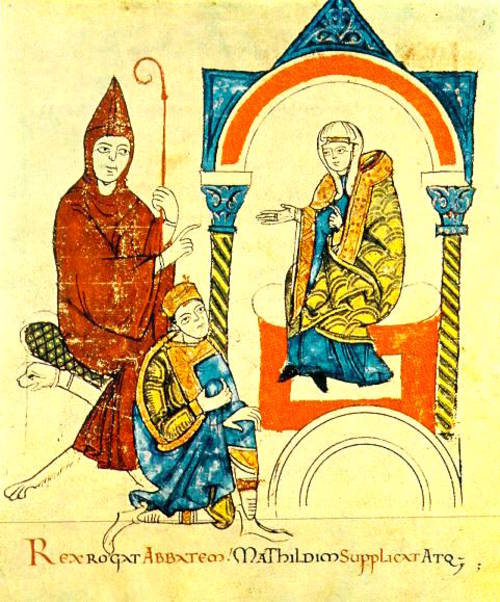Who was Matilda of Canossa? Last year, the Casa Buonarroti in Florence housed an exhibition dedicated to her, a woman who might seem to have little to do with the great sculptor who once owned the house that is now a museum to his memory. But the connection becomes clear when we are reminded of Michelangelo’s concern to prove that he was descended from an important family. He chose for his ancestors no less than the Canossa. Surviving letters from Michelangelo to his nephew, reminding him of this connection, prove his determination to establish this link. Amusingly enough, a letter even survives from a certain Count of Canossa to Michelangelo confirming their illustrious—if fictitious—parentage.

Matilda (1046–1115) is still one of the most famous women in history, and the 900th anniversary of death was celebrated in 2015 in various towns of Italy. The Italian expression andare a Canossa is still sometimes used to signify an action which involves great humiliation. For it was Matilda who, in her impregnable castle of Canossa, south of Parma, in 1077, proudly received the Holy Roman Emperor Henry IV, after he had waited outside the walls, barefoot in the snow in one of the bitterest winters on record, to ask her to intercede on his behalf with her great friend Pope Gregory VII to lift his excommunication.
But her story begins much earlier. Parchments bearing her signature survive to this day, her name written in a bold hand: Matilda dei Gratia si quid est. Quite simply: ‘Matilda who by the Grace of God is who she is’). Matlida’s father, Boniface, Margrave of Tuscany, administered vast territories in Italy on behalf of the Holy Roman Emperor. When he was killed, his wife Beatrice took over from him together with her daughter Matilda (then only aged six). By feudal law women were not allowed to inherit, so this action naturally led to disputes but Matilda managed to hold onto the land after her mother’s death. She allied herself with the pope and encouraged his independence, too, from the Holy Roman Emperor. To uphold her claim she used laws set down in the Justinian Code, since that great Roman emperor had established that female heirs had the same rights as male. Matilda employed distinguished jurists to study Justinian’s Digest concerning civil laws (which he laid out in just 27 brief and memorable sentences), including the fundamental concept that “all men are equal”.
Matilda spent her life founding or restoring cathedrals and churches in Italian territory (she is credited with some 100 such works) and facilitated travel between them, as well as building a circle of walls around Florence to keep the emperor out. She transferred her powers as ruler to the towns of Florence, Pisa and Lucca, and saw to it that the feudal claims of the Holy Roman Emperor over the people on Italian territory were extinguished. In effect she also helped to diminish the emperor’s secular power over the papacy, and supported Pope Gregory VII in his reforms (and formally left her lands to the papacy). As a young woman she often travelled with the Pope through Italian territory (her detractors suggested she was his concubine), and she promptly abandoned not one but two husbands when they took refuge with the Emperor. Indeed, the history of Italy’s free communes can with some justification be traced to her.
A contemporary biography of Matilda was written by a monk from Canossa called Donizone. It has delightful illustrations showing Matilda enthroned and very much in command. Another extant manuscript shows her with Anselm, Bishop of Canterbury. On her death she was buried in the monastery church of San Benedetto Po but in 1634 Urban VIII decided to transfer her remains to St Peter’s. He made history when he did so, as Matilda was not only the first woman but the first lay person, neither pope nor saint, to be buried there. Bernini designed the statue for her tomb. Her monument is mentioned in Blue Guide Rome and the ruins of her castle at Canossa feature in Blue Guide Emilia Romagna; but she will certainly get a stronger billing in the other Blue Guides to Italy from now on. One can only admire Michelangelo for choosing this Grancontessa as his ancestor.
by Alta Macadam






